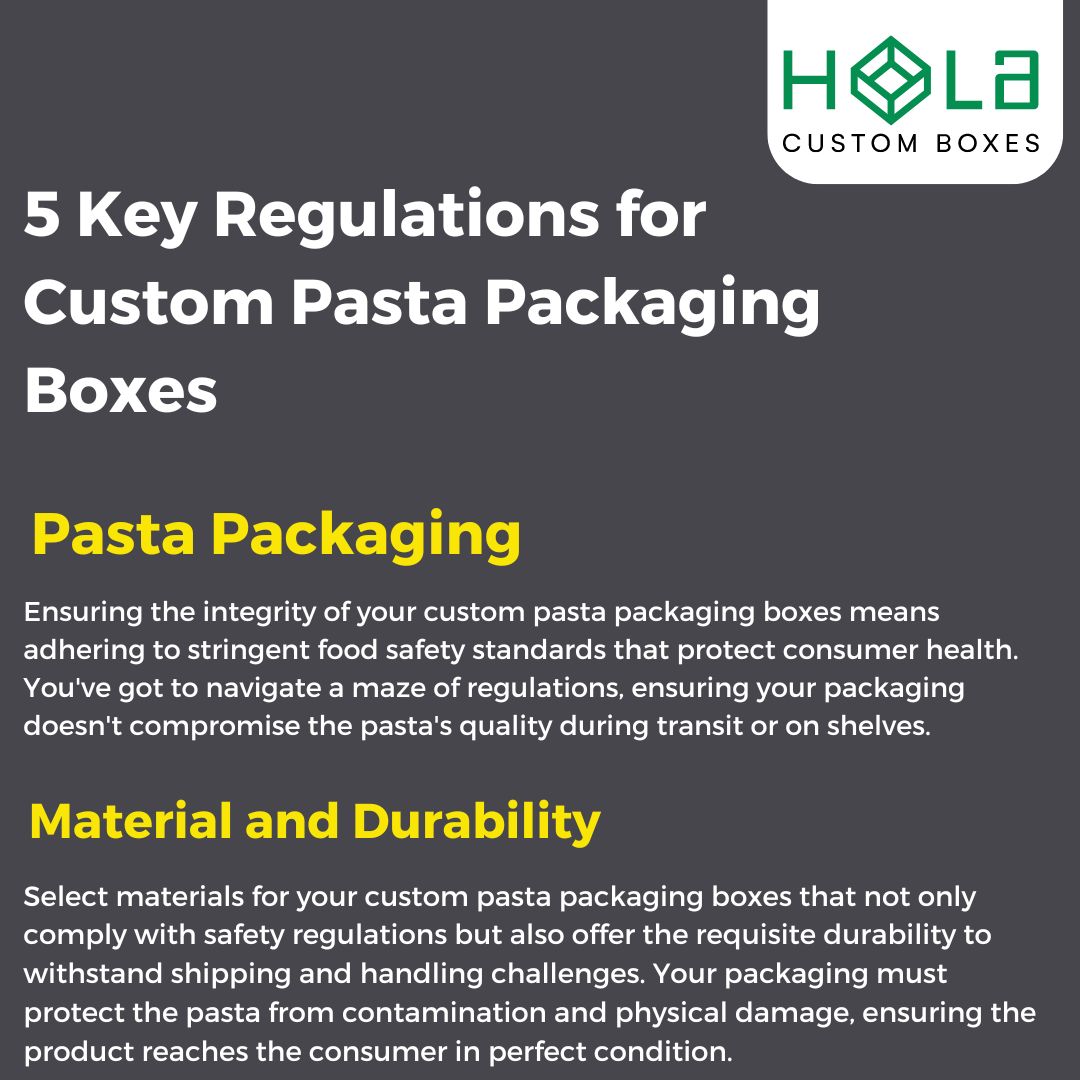5 Key Regulations for Custom Pasta Packaging Boxes
2025-11-28 13:03:03
Navigating the labyrinth of packaging regulations for your custom pasta boxes ensures your product not only stands out on the shelf but also complies with the essential legalities.
You must familiarize yourself with the food safety standards that act as the bedrock for all edible products' packaging. Choosing materials and ensuring durability fall under stringent guidelines to protect your pasta from spoilage and contamination.
You're also required to adhere to clear labeling and nutritional information mandates, which allow consumers to make informed choices about what they're eating. Don't forget, environmental and sustainability regulations are increasingly pivotal in a world that demands greener solutions.
Be mindful of the packaging size and transportation rules, which can significantly impact your distribution strategy.
Stick to these key regulations, and you'll set your pasta packaging up for success.
Key Takeaways
- Custom pasta packaging boxes must adhere to stringent food safety standards to protect consumer health.
- The materials used for custom pasta packaging boxes should comply with safety regulations, be safe for food contact, and not transfer harmful substances.
- Custom pasta packaging boxes should clearly display nutritional information and comply with FDA definitions and regulations for claims and allergen labeling.
- Environmental and sustainability regulations should be followed when designing custom pasta packaging boxes, including the use of recyclable or compostable materials and reducing carbon footprint.
Compliance With Food Safety Standards For Pasta Packaging

Ensuring the integrity of your custom pasta packaging boxes means adhering to stringent food safety standards that protect consumer health. You've got to navigate a maze of regulations, ensuring your packaging doesn't compromise the pasta's quality during transit or on shelves.
Your primary focus should be on materials that meet the Food and Drug Administration (FDA) requirements for food contact substances. You'll need to choose packaging that's resistant to contaminants and doesn't transfer harmful chemicals to the pasta. This means selecting inks, adhesives, and coatings that are safe for food contact. They mustn't contain allergens or substances that could lead to contamination.
It's also critical to ensure that your packaging is durable enough to protect the pasta from environmental factors, like moisture and pests, which could degrade the product. Additionally, your boxes should provide adequate barrier properties to maintain the pasta's freshness and extend its shelf life.
Pasta Boxes Material and Durability Requirements
Select materials for your custom pasta packaging boxes that not only comply with safety regulations but also offer the requisite durability to withstand shipping and handling challenges. Your packaging must protect the pasta from contamination and physical damage, ensuring the product reaches the consumer in perfect condition.
The materials you choose must conform to the standards set by food safety authorities, like the FDA in the United States, which stipulate that packaging materials must be safe for food contact. This means they can't transfer harmful substances to the food. Consider using cardboard or corrugated materials that are sturdy enough to protect the pasta during transit but also meet recyclability standards, reducing environmental impact.
Moreover, the durability of your packaging is vital for maintaining the integrity of the pasta. The box should be resistant to tearing, crushing, and moisture — common threats during transportation and storage. Assess the tensile strength, burst strength, and edge crush test ratings to ensure your packaging can endure the rigors of the supply chain.
As you finalize your material and durability decisions, you'll need to shift focus to the presentation of your product. The next critical step involves the application of labeling and nutritional information, which plays a pivotal role in informing and attracting consumers.
Cost-Effectiveness of Shipping Insurance
While shipping insurance comes with an added expense, its value lies in the significant protection it offers against potential losses. By covering damages, theft, or lost shipments, insurance ensures that businesses avoid bearing the full cost of unforeseen shipping mishaps, making it a practical and cost-effective safeguard.
Protection Against Financial Risks
Without shipping insurance, any loss or damage during transit can directly impact a business’s bottom line. The relatively small investment in insurance serves as a financial safety net, protecting shipments and providing peace of mind that outweighs the upfront cost.
Environmental and Sustainability Regulations
As a pasta packaging manufacturer, you're also bound by environmental and sustainability regulations that dictate the types of materials and processes you can use. These regulations are designed to minimize the environmental impact of packaging waste and promote the use of sustainable resources.
You must ensure that your packaging materials are recyclable, biodegradable, or compostable to comply with current green policies. Furthermore, you're expected to adhere to the guidelines set forth by the Federal Trade Commission (FTC) regarding the marketing of environmental attributes, which prevent misleading claims about the sustainability of your products.
You're required to reduce the carbon footprint of your manufacturing processes. This means investing in energy-efficient machinery, optimizing logistics to lower emissions, and possibly using renewable energy sources. Compliance with the Comprehensive Procurement Guidelines (CPG) program is essential, as it encourages the use of recovered materials in your packaging.
It's critical to stay abreast of evolving regulations, as non-compliance can result in hefty fines and damage to your brand's reputation. Moreover, consumers are increasingly environmentally conscious, and sustainable practices can be a significant market differentiator.
Now, let's transition to the regulations concerning packaging size and transportation rules, which also have substantial implications for your operational efficiency and environmental impact.
Pasta Packaging Size and Transportation Rules
Why should you consider the dimensions and weight of your pasta packaging boxes when planning for transport and distribution? Understanding the size and weight implications is crucial for compliance with transportation regulations and for optimizing your shipping costs. Here's what you need to know:
Maximum Weight Limits: Transportation companies often have weight restrictions. Ensure your pasta boxes don't exceed these limits to avoid additional fees or rejected shipments.
Dimensional Weight Pricing: Carriers may charge based on dimensional weight (a calculation based on size rather than actual weight), so efficient packaging design can save money.
Stacking Strength: Packaging must withstand stacking during transit. Adherence to box size regulations helps guarantee the structural integrity of your pasta boxes.
Pallet Compatibility: Standardized pallet sizes dictate box dimensions for efficient loading and unloading. Non-compliant packaging can lead to wasted space and increased costs.
Precise sizing and weight consideration not only ensure regulatory compliance but also facilitate the safe and cost-effective transportation of your pasta products. Stay informed about the latest transportation rules to maintain a smooth distribution process and protect your bottom line.
Conclusion
In conclusion, you must diligently adhere to key regulations for your custom pasta packaging. Ensure compliance with food safety standards, select materials that meet durability requirements, and accurately display labeling and nutritional information.
Don't overlook environmental and sustainability regulations, and be mindful of packaging size to comply with transportation rules. Staying informed and precise in following these guidelines will ensure your pasta packaging meets regulatory demands, safeguarding both your product and your business's reputation.
